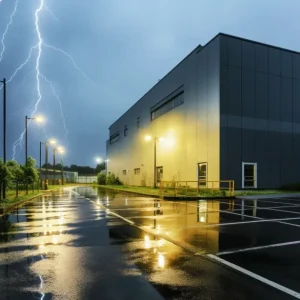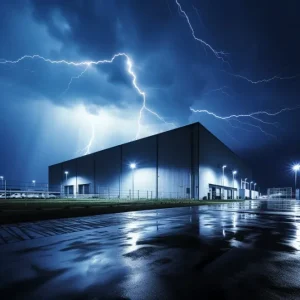Ever felt a tad uneasy not grasping the clear-cut difference between earthing and lightning protection?
You’re in the control room, glancing at the systems, and there’s that niggling thought, “Am I missing something crucial here?”
You’re not alone. Many face this, even those with decades under their belt.
And guess what? That’s perfectly okay!
We’ve all had those moments of doubt. So, fancy a proper chinwag to settle those jitters once and for all?
Right, let’s dive deep and unravel this mystery together, shall we? Let’s begin.
Unravelling Earthing & Lightning Safeguards
When it comes to safeguarding our electronic systems, understanding the basics of earthing and the various types of earthing becomes essential.
Did you know that internal lightning protection serves as a first line of defence against direct strikes? Yes, it’s that vital bridge between the external and your cherished electronic systems.
Both earthing and lightning protection play pivotal roles in the electrical world. But what are they, exactly? Ever considered your home as a fortress?
Now, think of earthing as its foundations – providing stability.
On the other hand, lightning protection acts like a shield, keeping those unexpected lightning strikes at bay. They might sound a bit similar, but trust me, they’re chalk and cheese.
Earthing’s Key Performance in Electrical Safety

Imagine this: a sudden fault in the power system, and what stands between potential disaster and safety? It’s the protective earth. Serving as a watchful protector, it decreases the chances of electric shocks, guaranteeing that everything stays connected and secure.
When we talk about earthing, we’re really diving into the world where every bit of the electrical circuit connects to the ground, or earth. This makes it a zero-voltage reference point.
Picture it like this: Ever seen those anchors on ships? Earthing’s pretty much the same for electrical systems. It makes sure they don’t drift into a hazardous zone.
Remember the metal parts of the devices you use? Those are essentially connected to the earth for safety reasons. It’s like the grounding touch we often need when things seem electrically charged around us!
Why Lightning Defence Matters Most
Think of lightning rods as the valiant knights atop your castle. These rods, along with lightning conductors, serve as dual protectors against the fierce power of nature.
Whether they’re defending against direct hits or providing internal lightning protection, these devices are pivotal for the integrity of power systems. It’s not just about the flash we see; it’s about the protection we don’t always notice.
Now, here’s a bit that’ll tickle your noggin. Why bother with lightning protection?
It’s simple, really. Every year, lightning strikes cause a ruckus – damaging properties, wreaking havoc on electrical systems, and, in worst cases, leading to fires.
Imagine you’ve got this swanky new control system. Out of nowhere, a storm rolls in and – bang! A lightning bolt hits, frying your beloved system. That’s where a protection device comes into play. It’s like having a brolly in a downpour, but for your electronics.
Diving into The World of Lightning Hits
Ever witnessed the sheer power of lightning? Without high-quality lightning protection, the damage can be catastrophic. From fried electronic systems to potential fire hazards, the wrath of lightning isn’t something to take lightly.
Ever wondered what it feels like to win the lottery? The odds of getting struck by lightning are not too far off.
But, unlike a jackpot win, a lightning strike isn’t the kind of surprise you’d fancy.
Every lightning bolt carries heaps of electrical energy. This energy needs a path to the ground, and, unfortunately, our buildings and structures often become that unintended path.
A proper lightning protection system makes sure that this massive energy finds a safe route, protecting our infrastructure and gadgets.
Harmonising Earthing and Lightning Defence
Everything’s connected—quite literally. The harmony between the earth electrode and lightning rods symbolises unity. They’re like the dynamic duo of safety, working in tandem to offer a protective umbrella against unforeseen electrical threats.
Now, here’s the kicker.
While earthing and lightning protection serve different purposes, they’re a bit like Ant and Dec – often working best together.
Picture this: a lightning bolt strikes, and the lightning protection system channels its energy.
But where does all that energy go?
Straight to the ground, thanks to the earthing system. It’s a tag team that makes sure our spaces remain safe and sound.
Witness Earthing and Lightning: Real-World Scenarios

Picture this: a large commercial building hit by lightning, and yet, no damage. Why? Because of an efficient ground electrode in place. On the other hand, a small establishment without a protective earth could suffer immense damage. It’s real-world proof of the saying, “better safe than sorry”.
Take The Shard in Türkiye , for instance. That massive structure isn’t just sitting there waiting for a lightning strike to throw it off balance. No! It’s armed with an advanced protection device that works alongside a brilliant earthing system.
Or consider hospitals. With all the critical equipment they house, you’d best believe they don’t leave things to chance when storms are brewing.
Distinctive Features You Shouldn’t Forget
Alright, here’s quick recap? Earthing focuses on connecting electrical systems to the ground, providing safety. It’s like the anchor for a ship. Meanwhile, lightning protection is all about diverting those mischievous lightning bolts, safely, acting as the guardian shield.
Every protection system has its unique traits. The effectiveness of internal lightning protection differs from other forms, and it’s these nuances that can make all the difference.
And when it comes to types of earthing? Knowing and understanding them can be your ace in providing holistic safety.
Both are crucial, and both have distinct roles. But together? They’re the dynamic duo of the electrical safety world.
The Vitality of Consistent Upkeep
Nothing remains efficient without a bit of TLC, right? The same goes for your lightning protection systems.
Making sure they’re of high quality is one thing, but regular checks of those lightning conductors and the protective earth system are equally paramount. After all, what’s better than a well-maintained shield?
The same goes for earthing and lightning protection systems. A routine inspection makes sure everything’s running smoothly, and you won’t be caught off guard when the next storm rolls around.
Top Strategies for the Eager Adopters
If you’re keen on upping your protection game, here’s a tip: always opt for high-quality components when considering internal lightning protection. It’s not just about the present but making sure your power system remains robust and resilient against future threats.
And remember, the risk of electric shock is real, but with the right strategies, it doesn’t have to be your reality.
For those of you keen beans looking to implement these systems, remember to always consult with an expert.
And while you’re at it, make sure the materials used are of top quality. After all, when dealing with something as unpredictable as lightning, you’d want the best kit in your corner.
Rounding It Off: Gearing Up for a Safer Tomorrow

We get it. Overseeing an industrial site is no small feat. There’s that nagging thought, right? “Have I done enough to protect my crew and equipment?” And that’s a fair concern. After all, with nature’s unpredictability, a storm could roll in any day, catching us off guard.
But take a breather and look back at what you’ve just absorbed.
We’ve unravelled the nuts and bolts of earthing and lightning protection. With these insights, you’re not just taking a step – you’re leaping towards a safer, more secure future for your site.
Picture a world where your infrastructure stands tall and unshaken, even as lightning bolts dance in the sky. Envision a crew that operates with peace of mind, knowing they’re shielded from unforeseen electrical mishaps.
Remember, every piece of knowledge you’ve gleaned today isn’t just data; it’s a weapon, an armour. With the right application, these tactics can transform your site into an impervious fortress, standing resilient against the might of nature.
So, go on! Harness these strategies, fortify your defences, and watch as you set a shining example for industrial safety.
Because when the next storm rages, while others scramble for cover, you’ll stand tall, beacon of assurance, leading the way.
And, that’s a sight worth standing up for.
FAQs on the difference between earthing and lightning protection
What is the difference between earthing system and lightning system?
Earthing systems, in a nutshell, are designed to keep electrical installations grounded. It’s all about providing a pathway for fault currents, protecting the safety of the equipment and people. On the flip side, lightning systems? They’re like the security guards of your electrical setup.
Their job? Shielding structures from direct lightning strikes, redirecting that immense energy safely to the ground. Bit like having a bodyguard for your electrical world, isn’t it?
What is earthing and lightning protection?
Earthing, in layperson’s terms, is about connecting electrical systems to the earth, grounding any rogue currents. Think of it as the safety net for your electrical trapeze act. Lightning protection, though?
That’s your knight in shining armour, defending your castle (read: structure) from those fiery arrows from the sky – lightning strikes. Together? They’re the dynamic duo safeguarding lives and infrastructure from potential electrical mishaps.
Does grounding protect against lightning?
Ah, a classic conundrum! Grounding (or earthing) makes sure that electrical installations are safe and fault currents find their way to the ground. But when it comes to lightning – that unpredictable beast – grounding alone doesn’t quite cut the mustard.
For that, you need a dedicated lightning protection system. Imagine trying to tame a wild lion with just a chair. You’d want a whip too, right? In this scenario, your lightning protection is that whip.
Can an earthing and lightning arrester be connected?
Interesting thought! Often, yes, they can be interconnected. The earthing system offers that critical path to the ground for fault currents. Combine it with a lightning arrester, and you’ve got yourself a solid team.
The arrester snatches the lightning’s energy, and the earthing guides it safely down. It’s like catching rainwater in a bucket and then pouring it down a drain – working together to prevent a splashy mess! But always consult an expert, yeah? Every site’s a bit unique.



